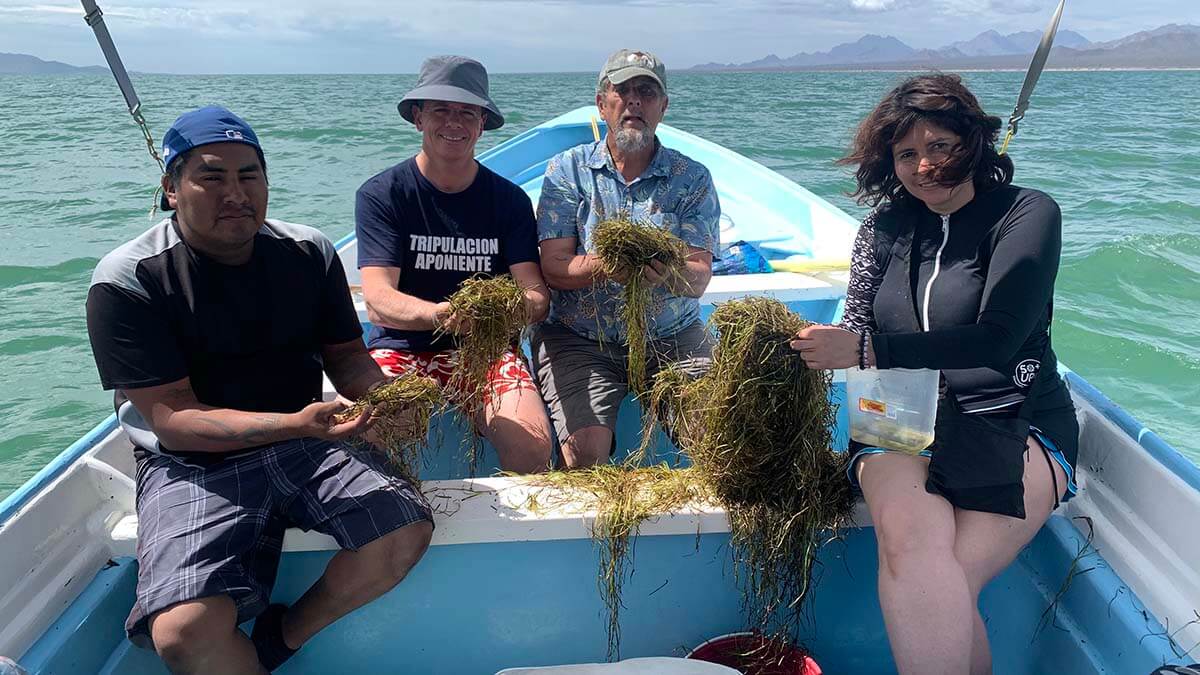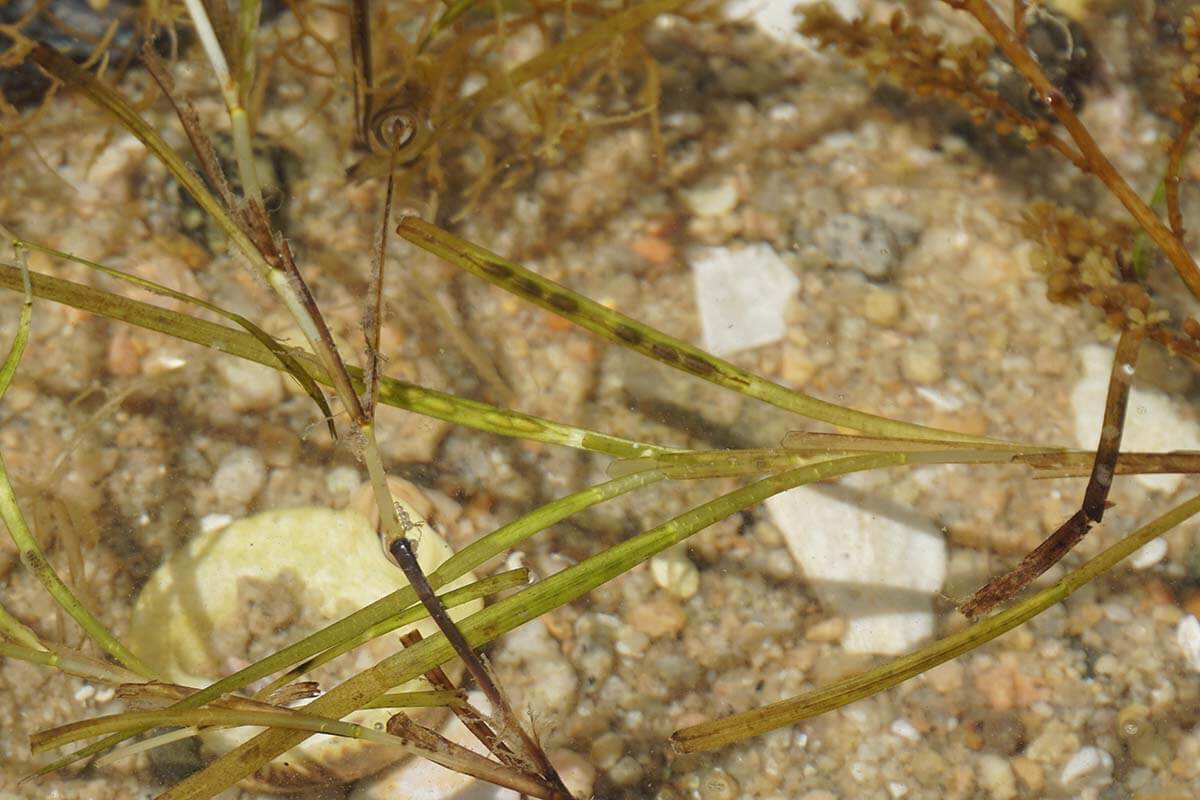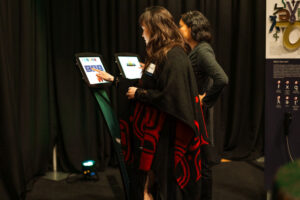The search for a sea grain known for centuries to an Indigenous people provokes deep questions and insights.
WORDS Gary Paul Nabhan | IMAGES Juan Martín

An eelgrass seed harvesting and monitoring crew boating out from the Comcaac village of Punta Chueca in the state of Sonora, Mexico.
We come back to the sea, humbly, not with answers but with deep questions.
Our eight-meter-long boat sets out into the emerald waters of the Sea of Cortés in the twilight before dawn. We begin to search for answers to the big questions that will occupy the minds and hearts of eight of us as we speed across the waves over the next week. We begin to search for a grain from the sea that most of the world has never known about, except for our beloved friends who live where the desert meets the sea.
We begin to search for a grain from the sea that most of the world has never known about.
Just before the sun rises above the desert mountains of Sonora, Mexico, hundreds of frigate birds soar above us, spiraling ever upward.
Are the frigate birds prognosticating a change in the air, a shift in barometric pressure, a disruption of weather patterns, or a concern for the state of the oceans?

The Comcaac are caretakers of the Canal del Infiernillo in the Sea of Cortés, Mexico, which harbors 96% of the eelgrass left in the Gulf and the largest population of seed-bearing eelgrass known in the Pacific.
As we speed northward into the Canal de Infiernillo — the narrow straits between the continental land mass and Isla Tiburón, the aboriginal home of the Comcaac or Seri, an endangered people — the skies darken. Their language — Cmiique Iitom — has also been called “threatened,” but it still harbors stories as nourishing as the eelgrass seeds (xnois) that rain down upon the sea bottom. The sky too begins to rain. Gray fog blurs the gaps between islands and peninsulas. Rays of sun shoot through the darkness, creating a rainbow before us.

A moment of comic relief out on the water: Gary Nabhan (right) sporting an impromptu eelgrass headdress, to the amusement of Alberto Mellado, a Comcaac elected official (left).
Are the sight of this arco iris and the smell of rain signs of a coming storm, or vestiges of one that had quickly passed us by? Is the sudden arrival of unseasonable rain — a rather rare occurrence in the month of May — an indicator of accelerating climate change? Are these meager raindrops sufficient to break the severe drought that is devastating more than four-fifths of all Mexican lands and waters? Will the sea levels rising here — rising far faster than in other parts of the world’s coastal plains — drown out or disrupt the connection between the Comcaac and xnois (grain)-bearing plants they call hatam?
The global loss of seagrass meadows is occurring at a rate faster than the loss of tropical rainforests. Ironically, these imperiled seagrass meadows may sequester as much ‘blue carbon’ per hectare as rainforests sequester ‘green carbon.’
As we navigate along the currents and enter a 30,000 hectare stretch of shallow shoals that harbor 10,000 hectares of eelgrass prairies, we realize that we were glimpsing the last best remnant of the most endangered marine ecosystems on the planet. The global loss of seagrass meadows is occurring at a rate faster than the loss of tropical rainforests. Ironically, these imperiled seagrass meadows may sequester as much “blue carbon” per hectare as rainforests sequester “green carbon.” To their good fortune, the Comcaac — one of the last hunting-fishing-foraging peoples left in North America — are keepers of an annual variety of eelgrass found nowhere else in the world. For the moment, it and its abundance of edible seed remain safe. Its scientific name — Zostera marina var. atam — echoes the Indigenous name for this blessed plant.

Eelgrass forming “sea pastures” in the Canal del Infiernillo.
Is it possible that any conservation organization, government agency, or nonprofit could better protect or more fully restore one of the last stands of eelgrass than the Comcaac community has done? Why is it here — in “Indigenous waters” on the western shores of the Pacific Ocean — that annual eelgrass has the best chance to survive and thrive as a food to benefit future generations of humankind and wildlife? Why is it here that a special eelgrass offers more seeds per square meter — 15,000 to 20,000 coffee-colored, flask-like gems — than marine ecologists have found anywhere else in the Pacific?
With such questions in mind, we ready ourselves to let our hearts and hands do work that our heads alone can never do:
To join with the Comcaac to harvest the seeds of eelgrass both for a village feast and for restoration sowings.
To sow the seeds in patches where they may come back to life and buffer the Comcaac villages from hurricanes and rising ocean level.
To move their vegetative offshoots into safer harbors where they might take root to produce future harvests of “wheat of the sea” to control diabetes and other nutrition-related diseases now afflicting the Comcaac.
To serve as the sheltered nurseries for the blue-eating crabs and flounder-like bottom-feeding fish they regularly harvest to eat.
Is it possible that such menial tasks might be done in such a way that the eelgrass benefits first the food sovereignty of the Comcaac Indigenous communities and then other people of diverse backgrounds who now struggle along seacoasts? Can they come to equitably share the same urgent mission: to keep Planet Ocean from becoming Planet Desert, where marine life becomes tragically depleted, dissipated, and disrupted?

Erika A. Barnett, eelgrass harvest team leader for the Comcaac, seen harvesting xnois seeds on the Sea of Cortés shore of Sonora. Photo: Gary Paul Nabhan
Our group of eight team members includes Indigenous Comcaac, Spanish, Mexican, and American scientists and culinary artists who have come together for a common cause: to respect, protect, and restore the living riches of Mother Sea, not just those of Mother Earth.
We are struggling to learn how it came to be that this remote place — held sacred by the imperiled Comcaac Indigenous community of Mexico — has continued to shelter nearly all of the remaining eelgrass meadows in the Sea of Cortés, even as eighteen other habitats where seagrass once flourished have disappeared. Has their culture coevolved with the eelgrass, forming a kind of marine mutualism not seen in other seascapes? Has their dedication to using this grain and to protecting its habitat for blue-eating crabs and sea turtles been the key to the persistence of xnois and of the Comcaac themselves?
We listen with salty tears in our eyes as one of the Comcaac leaders offers us this explanation:
“The roots of our culture, our histories, are embedded in these seagrass prairies, as are our songs and our prayers for the bodies of our fishermen who were lost at sea. Each of us remembers the place names that our ancestors taught us so that we may navigate and feed ourselves from these underwater sanctuaries. Our songs are maps that guide us to secret gathering grounds for sea turtles and other wildlife. They are as sacred to us as holy springs and mountain summits are to people who practice other religions. We have been nurtured and nourished by the seeds we call xnois, just as the fish and shellfish we eat have been fed to the underwater grass stalks we call hatam.”
‘The roots of our culture, our histories, are embedded in these seagrass prairies.”
How can it be that, until recently, no other culture in the world ever saw the value of feasting on the nutritious grains of eelgrass, even though they were first described in print by Padre Pérez de Ribas in 1645 and first seen by Padre Nicolás Perera soon after the Europeans began to explore this Mar Bermejo (Vermilion Sea) in 1539?

Drying hatam eelgrass on the beach in Punta Chueca, to winnow xnois seed.
Once we gather a large mound of eelgrass called eaz — the ripened, naturally uprooted plants that had been floating in the ocean — we give it to the most capable elderly women who remember how their grandmothers had prepared it. They beat the grassy mound with sticks until it sheds its seeds. They use trays to winnow away the seed from the chaff in order to save the edible grain.
In a matter of days, they separate and clean several kilos of xnois seeds by hand. They take half of it and mix it with boiling water and honey to make a delicious cereal or porridge to share. They make balls and thick tortilla-like patties from it. They invite the community to celebrate the revival of this gastronomic tradition. A dozen community members quickly step forward to taste an ancient grain that no one had prepared on such a scale for more than fifty years.

Left: Grinding xnois with a traditional stone mortar (molcajete) and pestle. Center: Making tortilla dough with ground xnois. Right: Separating the xnois dough to make tortillas.
.

Left: Xnois tortillas on a comal griddle, ready for cooking. Right: Cooking the xnois tortillas.
How do the rest of us collectively “pay our debt” to the only known culture in the history of humankind that has harvested this most delicious and nutritious grain from the sea?
Our collective harvesting efforts during just one week in May seem minuscule in comparison to those of a fishing, foraging, and sea-faring culture that has kept alive the knowledge of this valuable grain for centuries, if not millennia. Nevertheless, we do what any coastal dwellers who live near eelgrass beds can do on their own:
We rake up mounds of eelgrass found floating in the shoals, sort through them, and secure several hundred viable seeds that we plant back into the ocean.
We place ten eelgrass seeds in each of several burlap bags that we have sown by hand, then anchor the bags in open areas along the bottom where they can recolonize the soil.
We separate out the healthiest offshoots called rhizomes. We dive with them to the bottom of the channel. We punch five at a time together into a hole we dig along the ocean bottom. We do the same every few meters along a line in the sand, so that we can track how well they grow.

Comcaac dolls made of eelgrass. Fashioning dolls as girls’ toys is another traditional use of this invaluable sea plant.
Is it not by small steps such as these that we come to heal the holy earth and its sacred waters?
Is it not possible that these salt-tolerant, rice-like grains might nourish future generations of Comcaac when freshwater has become painfully scarce?
Is it plausible that their dietary fiber and anti-diabetic properties might save the lives of Comcaac women and men who suffer from nutrition-related diseases brought on by malnutrition and poverty?
We watch as the sun cascades through the emerald waters to recharge the energy reserves of these resilient plants. They dance delicately in the water as the winds and waves move in rhythm.
How can the Comcaac use this gift from the sea to recharge the energy of our own societies, to restore this ancient food to its proper place in our salty world?
We sometimes say to our children, or even to our pets, “Don’t bite the hand that feeds you.”
Now the remaining seagrass meadows seem to be calling to all of us, but especially to the Comcaac themselves: “We are grateful for your centuries of care, but do not squander the eelgrass grains that you may soon need to feed your children.”

An eelgrass meadow in the Canal del Infiernillo, floating as the sun cascades through the emerald waters.
Learn more about Gary Nabhan.
Back to Vol. 11 | Read the Table of Contents | Like Our Stories? Please Donate!
 .
.
Gary Paul Nabhan is an Arab-American ethnobotanist and writer of literary natural history. As an Ecumenical Franciscan brother and contemplative ecologist, he has worked on conserving and restoring the links between biodiversity and cultural diversity in the U.S.–Mexico borderlands and in the Middle East.




